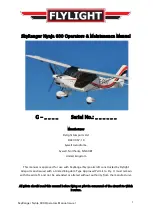
14
Section 4. PERFORMANCE AND FLIGHT CHARACTERISTICS
Check and adjust your harness. We strongly recommend that you hang as
low as possible (as close to the speedbar as possible). Be sure that no part
of the harness touches the speedbar while pilot moves over the whole
range as he or she will move in flight.
4.1. Take off
Make sure you are hooked in and check your position hanging in the
control bar.
Make the flaps ON by 1/3-1/2 way.
Make sure RWG is OFF. It is not allowed to take off with RWG ON
If the wind is more than 8m/s (18 mph) or is gusty, you have to have at
least one wire assistant on the nose wires and side assistant. The Phantom
has a slight tail heavy static balance, which does not take effect during
take off
.
When you hold the glider prior to your take off run, you should keep the
nose slightly up and wings level.
The glider takes off easily in zero winds as well as with strong winds and
does not require any special methods of handling.
4.2. Flying
At first handling performances of the Phantom seem to be different from
those inherent in other gliders. The reason is that Phantom handles easily
at any speed. Don't worry, you'll soon get used to it. Make your first flight
in easy flying conditions.
4.3. Flight Speed
Remember that the range of flight speed depends on the wing load. If you
have big wing load and you fly at minimum speed for the small wing load,
you can get a stall.
Refer to the diagram below to determine trim speed that corresponds to
your hook in weight, and adjust hook in point in order to achieve this trim
speed. Trim speed must be a little higher than minimum sink speed. So, in
thermals when you want to fly at min. sink speed, you should push the
bara little.
Flight speed
25,0
30,0
35,0
40,0
45,0
50,0
55,0
60,0
70
75
80
85
90
95
100
Hook in weight, kg
S
p
e
e
d
,
k
m
/h
Stall speed, full flaps
Safety Vmin, full flaps, stright flight
Stall speed, flap 0
Safety Vmin, flap 0, stright flight
Min sink speed
Max glide ratio speed
Trim speed







































